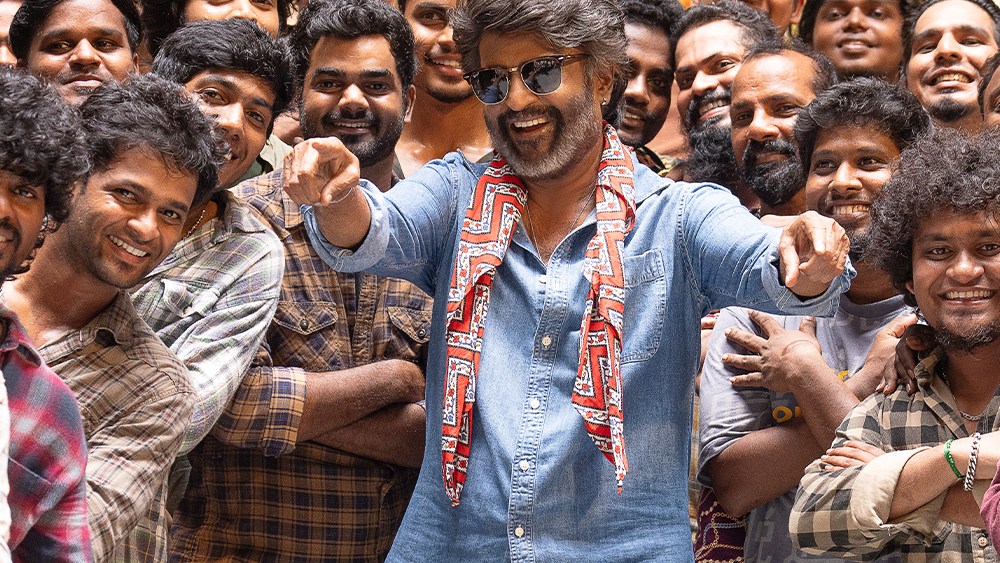At 74 years old, Tamil legend Rajinikanth remains effortlessly suave, making him worthy of not one, but two of his own logos prior to “Coolie,” his 170th film. Director Lokesh Kanagaraj’s latest is a cheer-out-loud crime saga in which hyper-violence has the gracefulness of dance. It has a lead character so magnetic that even its story’s messiest, most convoluted parts remain fixed around his orbit, as he goes supernova once more.
Kanagaraj’s grimy, lurid approach may seem like a strange bedfellow for mass-appeal hero worship. But if his films have proved anything, it’s that he’s incredibly adept at striking balance, grounding the star power of stylish lead figures like Kamal Haasan, while filtering character actors like Vijay Sethupathi through an operatic lens, compromising on the strengths of neither category. In “Coolie,” Rajinikanth receives the former treatment as Deva, an altruistic labor leader who runs a hostel for interloping youth, while Soubin Shahir (the lead of Malayalam-language survival drama “Manjummel Boys”) is transformed into the sinister Dayal, a dock manager working for a mysterious crime syndicate.
When an estranged friend of Deva’s turns up dead — the kindly inventor Rajasekar (Sathyaraj), seen mostly in flashbacks — he seeks to solve the murder while teaming up with Rajasekar’s untrusting adult daughter Preethi (Shruti Haasan), a woman trying to make ends meet for her younger sisters. The duo’s sleuthing leads them to Dayal’s outfit, where he and his rich, megalomaniacal, machete-wielding boss Simon (Nagarjuna) are trying to purge their gang of moles by any means necessary — even if it means killing random dock workers as warnings to potential informants. It soon becomes clear that, in trying to infiltrate Simon’s dock to find his friend’s killer, Deva has bitten off far more than he can chew. Soon, battles of both the ethical and fisticuff variety come charging his way.
The initial plot revolves around a secret invention, by which the gang cremates bodies within seconds via an electric chair-like contraption, perverting the religious traditions glimpsed at Rajasekar’s Hindu funeral. Symbols of religious corruption abound at every turn — at one point, Simon crucifies one of his workers to a chair — a spiritual darkness that extends to Deva breaking three decades of sobriety to tap into his most violent instincts. The movie’s first half sets up each theme and subplot with laser precision, complemented by Philomin Raj’s clockwork editing, and an enrapturing electronic score by Anirudh Ravichander, one of India’s cinema’s rising musical stars.
After its intermission, however, “Coolie” gets a bit sloppy, between head-spinning twists that pile up too fast to process, and some uncomfortable optics around how frequently Preethi’s part is reduced to a crying damsel in distress (she’s kidnapped about half a dozen different times). But with Kanagaraj at the helm, and Rajinikanth enveloping his frame as a benevolent paternal figure, “Coolie” speeds past these mounting shortcomings with panache.
Kanagaraj and cinematographer Girish Gangadharan move through space with fluid intensity, while the film’s septuagenarian lead warps space and time around his movie star stature. Rajinikanth is practically in a footrace with the movie itself: the more complicated its story gets, with strangely elaborate plot devices revealing family secrets through coded phone calls, the more he employs his signature, snapping gazes and wry smiles — not to mention, his ability to make convincing even the most ludicrous feats of strength.
The film also features flashbacks to three decades prior, which de-age Rajinikanth to the peak of his action career, but disguise the seams of this imperfect digital process by adding the flaws and texture of faded film grain. “Coolie” — whose title means “laborer” — takes a while before laying its thematic cards on the table, but its story eventually builds to a rousing saga of union solidarity in the face of wealthy predators, who get rich off workers before discarding their bodies.
Kanagaraj’s usual mode of filmmaking, in which story beats dovetail effortlessly between toe-tapping musical numbers (and are sometimes woven in-between them) works especially well for a film with a plot that can be headache-inducing. Sometimes all you need for a mid-movie reset is a familiar cameo. Or a dance to a club banger sampling dialogue from “Breaking Bad.” Or a musical number backed by a sprawling sea of extras, moving just out of sync so they resemble sound waves as they give a sensuous tribute to Monica Bellucci.
“Coolie” is, on its face, a ridiculous, often impenetrable story. However, its aesthetic triumphs outweigh its imperfections, thanks to some of the most dazzling and thematically turbo-charged on-screen bloodshed you’re likely to see this year.

